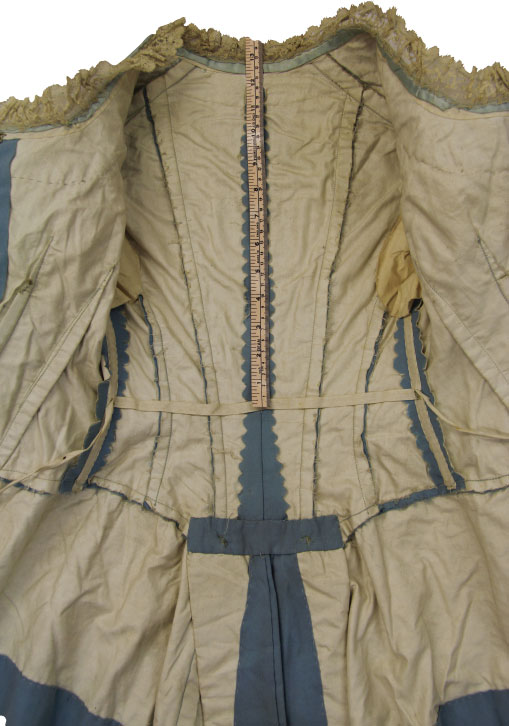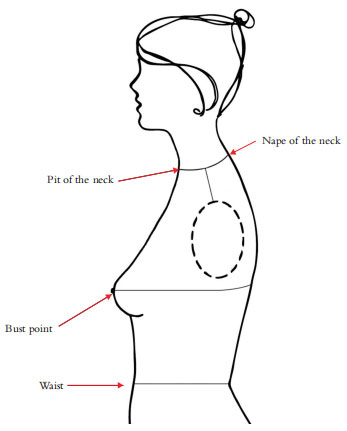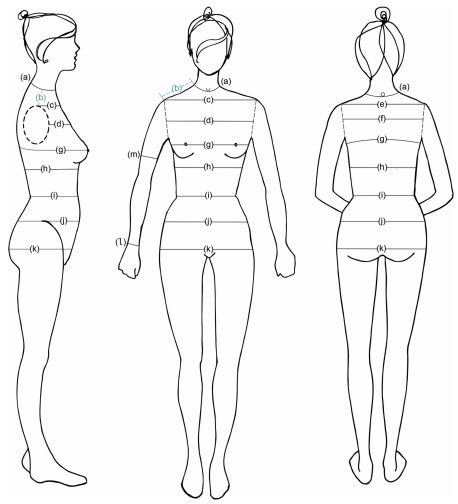Measurements
Having established the garment’s date, placed it in its historical context and assessed its condition, you will now need to take accurate and informative measurements in order to create an appropriately shaped mannequin for display. This chapter explains the essential measurements you will need to take, where to take them and the most useful tools for the job.
Developing accurate measuring skills is the key to successfully displaying a garment on any type of mannequin. Understanding the relevant measurements needed and developing the techniques to take them accurately is the best way to ensure a good result.
Repeatedly trying garments on mannequins to check their fit is extremely stressful for both the garments and the person dressing the mannequins. Accurate measurements with the correct reference points can greatly reduce the number of fittings needed.
Always follow the measurements but remember that the garment has to fit over the support so the measurements of the mannequin or bust form will always need to be smaller than the actual measurements of the garment. How much smaller is dependent on the style and condition of the bodice of the garment. For a heavily boned bodice with a tiny waist this could be up to 10 centimetres smaller around the bust for the first fitting.

Figure 5.1 The existence of a waist tape attached to the centre back seam of this jacket is a useful reference when taking the centre back neck to waist measurement. The actual waistline being the bottom edge of the waist tape. Blue wool bodice and skirt, c.1875. © The Bowes Museum, Barnard Castle, County Durham, England. Photography Robbie Pettigrew.
Taking accurate measurements of garments is also essential before purchasing mannequins. However, always remember, it is not only the bust, waist and hip measurements which are important, but also how they relate to each other which will affect the size required. This is explained in more detail later in the chapter. If in any doubt always purchase a smaller mannequin. It is much easier to add padding to a mannequin than reduce its size.
Measuring
Fashionable clothing is designed to fit around a person’s body and in order to understand garment measuring it is necessary to become familiar with the vocabulary, the ‘language of measuring’, used when measuring the human body. Although the style of garments has changed over the centuries, the terminology used for taking and recording the body measurements needed to make clothing has remained basically the same. There are four main reference points on the female body to which most measurements relate (see figure 5.2).
• The bust point
The most important reference point on the female body is the bust point. It is the central point of the bust and corresponds to the position of the nipple. Knowing its exact location is of vital importance when trying to create a support for any garment. Its position is usually recorded as a vertical measurement taken from the middle of the shoulder to the nipple. The position on the shoulder is not a fixed point but an estimated centre point halfway between the side of the neck and the shoulder bone at the top of the arm. On the body it can also be taken from the centre-back neck, over the shoulder at the side of the neck to the nipple. However, this method is difficult on a garment, particularly one with a low neckline.
• The waist
The narrowest circumference around the middle of the body is known as the waist.
• The pit of the neck
This name is given to the small depression at the base of the neck at the centre front, between the collarbones and at the top of the breastbone.
• The nape of the neck
This is found at the centre back at the base of the neck below the seventh cervical vertebrae. It can be felt as the large bump at the base of the back of the neck.

Figure 5.2 Drawing showing the relative positions of the pit of the neck, nape of the neck, the bust point and the waist. © Drawing author, courtesy of Historic Royal Palaces.
Width measurements on the body

Figure 5.3 These are the horizontal circumference measurements. To be accurate they must be taken with the tape measure parallel to the floor. Standing at the side of the figure gives a good view of the front and back of the body. The neck and shoulder measurements are the exceptions. © Drawing author, courtesy of Historic Royal Palaces.
Description of the horizontal body measurements
| MEASUREMENT | LOCATION AND DESCRIPTION OF THE HORIZONTAL BODY MEASUREMENTS | |
| (a) | Neck | Measured around the base of the neck across the pit of the neck at the front and the nape of the neck at the back. It is the position where the bottom of the collar on a fitted shirt would sit. |
| (b) | Shoulder | Looking down at the shoulder from above this is a central line taken from the side of the neck to the bone at the top of the arm. |
| (c) | Across front shoulder | Measured across the base of the neck at the front from the shoulder bone at the top of one arm (known as the shoulder point) to the shoulder bone at the top of the other arm. |
| (d) | Across front chest | Measured across the front chest from armhole to armhole approximately 10 cm (4 inches) down from the pit of the neck at the centre front. |
| (e) | Across back shoulder | Measured across the back of the neck from the shoulder bone at the top of one arm to the shoulder bone at the top of the other arm. |
| (f) | Across back | Measured across the back chest from armhole to armhole approximately 10 cm (4 inches) down from the nape of the neck. |
| (g) | Bust | The bust is the widest part of the chest, and is measured across the front through the bust points (nipples), under the arms and across the back, making sure to take the tape measure over the bottom of the shoulder blades at the back. This may necessitate raising the tape measure slightly across the back. |
| (h) | Ribcage | Measured horizontally around the ribs below the bust. |
| (i) | Waist | Measured around the body at the narrowest part of the torso, through the navel or approximately 2–3 cm (1 inch) above. **This will depend of the shape of the body of the person being measured and the position of the navel. Wherever the navel is situated this measurement is always the narrowest part of the torso. |
| (j) | Top hip | Measured 10 cm (4 inches) below the waist. This measurement is taken around the body, across the abdomen and over the hipbones, with the tape measure kept horizontal. |
| (k) | Hip | Measured 20 cm (8 inches) below the waist. This measurement is taken around the widest part of the buttocks and over the bones joining the top of the legs to the pelvis, keeping the tape measure horizontal. |
| (l) | Wrist | Measured around the wrist over the wrist bones. |
| (m) | Bicep | Measured around the arm, half-way down between the shoulder bone and the elbow. This measurement is very important when displaying a short-sleeved dress. |